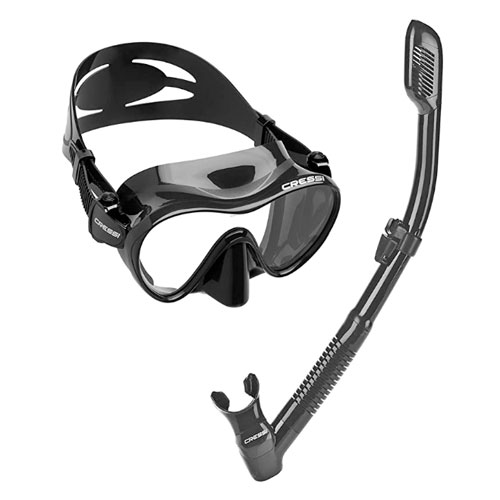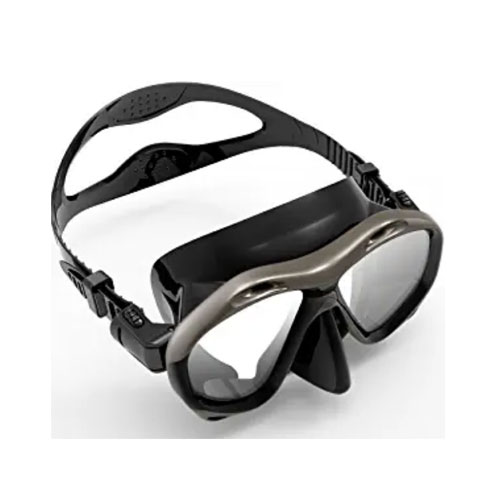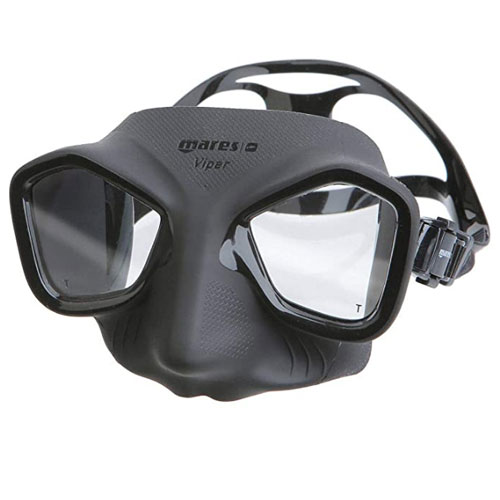-
1.
-
2.
-
3.
-
4.
-
5.
Freediving is a relatively advanced sport that is between snorkeling and scuba diving. You use equipment similar to snorkeling, however, go to depths that scuba divers may go to. As you hold your breath to dive below the surface in the exploration of the underwater world, you require a mask that can go with you. Some snorkel masks feature too much airspace in the mask which doesn’t make them ideal for diving below the surface.
If you are interested in the ever-growing sport of freediving you will need the best freediving mask you can get. This will help you reach and exceed your goals. Your setup should have the best mixture of features that help you when underwater. The best mask will feel like you’re not even wearing one.
We have researched to find the best freediving mask on the market. The features to look for range from the volume of the mask to the materials used for the skirt. Even the strapping system can affect how these masks feel when in the water.
Ready to get started? Let’s go!
OUR TOP PICK
Cressi Scuba Diving Snorkeling Freediving Mask
- What Makes This Freedive Mask Stand Out
- Low volume mask
- High-end materials
- Wide field of vision
EDITORS CHOICE
Kraken Aquatics Snorkel Freediving Mask
- What Makes This Freedive Mask Stand Out
- Anti-fog, scratch, and shatter-resistant lens
- Versatile mask
- Exceptionally durable
BEST VALUE
SeaDive Oceanways Superview Freediving Mask
- What Makes This Freedive Mask Stand Out
- A single piece of glass lens
- Color corrected lens
- Specially designed coating to reduce UV and glare
Cressi NANO Expert Adult Freediving Mask
- What Makes This Freedive Mask Stand Out
- 2 patents filed for this mask
- Ultra-low volume
- Unbreakable buckle
- What Makes This Freedive Mask Stand Out
- Prescription lens compatible
- High-grade materials
- The high tech strap system
- What Makes This Freediving Mask Stand Out
- 180-degree field of vision
- Comfortable
- Anti-fog
Scuba Choice Freediving Mask
- What Makes This Freediving Mask Stand Out
- Silicone
- Tempered glass
- Good for narrow faces
XS Foto Panorama Freediving Mask
- What Makes This Freediving Mask Stand Out
- 3-window lens
- Qwik strap
- GoPro mount
Aqualung Micromask Freediving Mask
- What Makes This Freediving Mask Stand Out
- Great field of view
- Low volume
- Compact
Mares Viper Freediving Mask
- What Makes This Freediving Mask Stand Out
- Anti-condensation
- Ergonomic design
- Adjustable
How To Choose A Freediving Mask – Buying Guide
Freediving mask reviews agree that, unlike snorkeling masks, freediving systems have to be finely tuned. Since every single second underwater count, your mask should have technology built in to extend that time. Having a mask that features a low profile design and less internal volume will ensure that you can dip below the surface with ease. When looking for your ideal mask, be sure to pay attention to the following features.
Low Volume Please
When you free dive you need to conserve as much air as possible for the most amount of time. A low-volume mask retains less air than a larger volume option. More air means more buoyancy which translates into more effort.
These masks will also have specially designed nose areas. Just like scuba diving, freedivers go to depths that require you to equalize. This means you need to be able to easily block your nose.
Fits like a glove

A low-volume mask will need to fit your face perfectly. Large volume masks will keep the lens away from the contours of your face. For this reason, a silicone skirt is almost a requirement. It will bend and flex as your face moves and create a watertight bond.
Tips On How To Wear Your Freediving Mask:
-
- Tilt your head back and rest the mask on your face without putting the strap on. Make sure that every part of the mask is positioned properly.
- Breath in through your nose to create a seal between your face and the mask. As you breathe in, tilt your head to a normal position. If it stays on your face without any leaks it is a good fit. If it falls off your face you will need another size of the mask.
- If it fits properly, holds the front of the mask and use your other hand to put the strap over your head.
- From here you will be able to adjust the mask so that it fits comfortably on your head.
- Once this is complete you’re ready to get in the water.
Pro Tip: Do all of this before you head on your diving vacation. It will get you in the water much quicker than having to struggle while you’re in the water.
Single or Double pane Lens
Both of these types of lenses offer great results. The single-lens gives a slightly better interview, while the double lens may offer the opportunity to be replaced with corrective lenses. With that being said, you should always make sure to get a tempered glass lens. Nearly every single mask that includes tempered glass is also scratch and shatter-resistant. This doesn’t mean you can throw your mask on the ground, but it will have increased durability.
Some specially designed lenses also have color correcting. As you dive to deeper depths, the colors of the coral and fish around you fade away. Red is first to disappear, at around 10 feet, with yellow following close behind at 20 feet. Some masks will compensate for this through their lens while others increase the brightness as well.
Color of the seal and lens
Most of the time color comes down to your style. This isn’t the case with freediving masks. A bright-colored skirt or seal can lead to your vision being obstructed. This is due to the glare that it can cause when at depth. If you are using these masks for spearfishing as well, a brightly colored skirt can scare away your prey. If you use a clear skirt, you also risk the light getting through the skirt and obscuring your vision more. We would recommend using a plain black skirt, even though it is not flashy.
Colored lenses, on the other hand, can also have unwanted effects. Dark colors can make your eyes less visible to your dive buddy. This isn’t ideal as your eyes are an important point of connection between the two of you. Near the end of your dive, it can be a safety issue if your diving buddy cannot see your eyes. For this reason, we would always recommend clear lenses when you are diving down deep in the water.
A polarized or UV-protected freediving mask, on the other hand, maybe a great option. These will filter out UV rays and bright light, much like a pair of sunglasses. This is helpful when you are on dry land and in the water. If you are preparing for your dive, you are not irritated by the sun. The same is true for when you come up for a breath. The glare on the surface of the water can be dazzling. The deeper you go in the water, the less you will need polarization so the choice will depend on the type of diving you are doing.
You might also be interested in:
FAQs

Q: How To Clear Your Mask When Freediving?
This is something you shouldn’t have to do when freediving. It is so important to get a mask that fits properly so that you don’t have to worry about it leaking while you’re under the water. If you find your mask keeps filling with water you should check that there is nothing wrong with it especially if it’s a newer buy. Another issue can be the sizing. Masks that regularly leak may not fit your face properly. For example, if the seal doesn’t properly wrap around your eyebrow it can let water in. The same goes for facial hair. This can cause your mask to not create a seal which will lead to your mask leaking.
With that being said, if it does leak for some reason clearing it is relatively straightforward. Tip your head backward and underwater push on the top part of the frame while breathing through your nose. You should notice that the water in your mask will start to drain. Just keep in mind that this won’t fix what’s causing your mask to fill with water. You may need to tighten the mask more or adjust it so it’s centered on your face.
Q: How To Equalize When Full Face Mask Freediving
You should only look to purchase specially designated free diving or scuba masks. They will have a soft nose cap that will allow you to squeeze your nose to equalize the pressure. To do this you should use your fingers to pinch your nose and breathe through it. Start by breathing gently through your nose. If this doesn’t work, start breathing slightly stronger until you hear a pop. This will release the pressure in your ears and allow you to descend deeper.
Pro Tip: If you can’t equalize, ascend a few feet and try it again. This will usually allow you to release the pressure.
One important thing to remember is that you can’t equalize too often. But if you don’t equalize properly you can do serious damage to your eardrums. You shouldn’t dive if you have a cold, especially one where you are congested. This can make equalizing nearly impossible.
Q: What Is The Difference Between Scuba Diving And Freediving?
Scuba diving gives you some breathing apparatus to use under the water. With freediving, all you have is your mask, your fins, and your wetsuit. Freediving is done holding your breath. The aim is to stay under the water for as long as possible in one breath. Now, this does not mean that you have to dive as deep as you can. Many people use freediving to go spearfishing under the water or to dive for pearls.
Q: Why Does Water Leak Into The Mask?
With any underwater activity, a mask is there to protect your eyes from the water. The mask is designed to keep the water out, but there will be times when the water leaks in. So, is there anything which you can do about this problem?
If a mask lets in a lot of water, it will become annoying and impossible to swim underwater. If you have followed our method for fitting your mask, then a lot of water will not be able to get in, but over time, small amounts may seep in.
If your hair gets in the way, it can disturb the seal and let water in, so make sure to check that your hair is out of the way. If you have a good fit, but the water still gets in, then you may want to try vaseline under the seal to fill any gaps where the water is getting in.
If you have tried everything and the water is still getting in, then the only hope is to find a new mask.
Related Post: Scuba Mask Leak
Globo Surf Overview
Freediving is a lesser-known sport that’s increasing in popularity. Taking your snorkeling experience one step further, diving below the water’s surface allows you to explore, follow fish and continue to explore coral reefs. Exploring intermediate depths of the water will allow you a unique opportunity to immerse yourself in all the life under the sea.
It not only tests your physical ability but also your mental endurance. While holding your breath below the surface is a challenge, having the mental strength to explore without air is an achievement of its own. Many places around the world allow people to test themselves and beat their own goals. The best freediving mask will not only help you increase your depth but also allow you to see the underwater world around you with clarity. Remember that freediving is all about having fun. The best gear will only go so far. Understanding the best forms and techniques will help you to succeed in this sport.
More Scuba Reviews:
- BCD
- Dry Suit
- Scuba Fins For Travel
- Air Integrated Dive Computer
- Bcd For Beginners
- Dive Boots
- Dive Compass
- Freediving Fins
- Freediving Watch
- Scuba Tank













